Hello dudes and dudettes,
The week might have gone well for most of you with Bond having risen on Friday. But mine wasn't really great. I had an aweful 7-day working week, with classes even on Sunday! With the phase test(its a termly exam in the IITJEE format) closing in on next monday, all the teachers, and the students of course, are gearing up to make it to success there. This is because, the nest phase test shall be a reshuffling one, and shall include all the lessons we've done so far!
So, here we go:
*Let me tell you that I have quoted a few lines, which wer best left untouched, from various sources(apart from wikipedia). And I heartily credit them, though I do not wish to mention them here. But with proper googling skills, you can find them out yourselves.
Windows 7
What if Microsoft waved a magic wand and everything people hated about Windows Vista went away? You might have an operating system that you liked--and that's what Microsoft appears to be striving for with Windows 7.
Windows 7 (formerly codenamed Blackcomb and Vienna) is the next version of Microsoft Windows and the successor to Windows Vista. Microsoft stated in 2007 that it is "scoping Windows 7 development to a three-year timeframe", and that "the specific release date will ultimately be determined by meeting the quality bar."
Microsoft has said all along that Windows 7 would refine (but not rewrite) the Vista kernel. However, some of the anticipated changes depend on support that Microsoft may not be able to control. For example, a number of cool network features will work only if your employer installs Windows Server 2008 R2 (also handed out to reviewers). Other new features require cooperation by hardware vendors, though this time their contribution won't extend to rewriting drivers. Still other changes involve slimming down the code by offloading applications (such as e-mail and photo management) that were once bundled with the code. With Windows 7 you'll get them either as downloadable apps or as Web services.
Interface
Windows Vista's interface makeover emphasized style over substance: Among its most-hyped new features were the Aero user interface's translucent window frames (woo-hoo!) and the Flip 3D window switcher (flashy, but not particularly useful). It didn't do much to repair Windows' reputation for being annoying; in fact, the in-your-face tactics of the new User Account Control security feature made Vista more aggravating. And much of what was new in Vista, such as its desktop search, amounted to Microsoft playing catch-up with Apple's OS X.
Windows 7 takes a strikingly different approach. Its interface contains plenty of tweaks, but they're relatively subdued and they emphasize everyday efficiency rather than sizzle. Several of the changes aim specifically to get the OS out of your way so you can work without distractions. And virtually none of what's new feels like warmed-over OS X.
The changes start with the Windows Taskbar, a core component of the Windows experience that has changed very little since it debuted in Windows 95. With Windows 7, it undergoes its biggest remodeling job ever: The familiar bars containing the name of a running application and a tiny icon are gone, and in their place are unlabeled, jumbo icons that represent running applications. The icons look like gargantuan versions of the tiny icons in the old Taskbar's Quick Launch toolbar--as well they should, since they supplant Quick Launch in W7. (The new Taskbar also looks a bit like OS X's Dock, though it doesn't behave like the Dock.)

Vista's Taskbar introduced thumbnail-size previews of windows that would appear when you hovered the mouse over an app in the Taskbar. They were fairly handy, but if you had multiple windows of an application open--say, several browser windows or several word-processing documents--you could see only one of them at a time. In Windows 7, thumbnails for multiple windows appear onscreen simultaneously, in a ribbonlike horizontal strip. Hover over a thumbnail, and you get a full-size preview of the window; you can also close windows from the thumbnails.
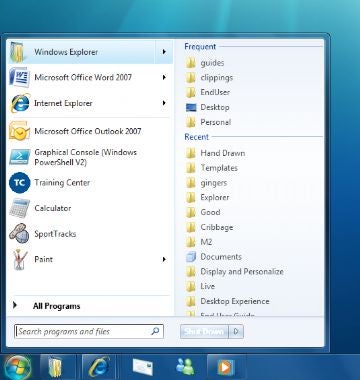
Click on an icon in the Taskbar--or on a program in the Start menu--and you get a "jump list," a new Windows feature that's a twist on the context-sensitive menus that the OS has had for years. Jump lists provide one-click access to various tasks associated with an application--Play All Music for Windows Media Player, for instance, or a list of recently opened files in Word or Excel.
Not every jumbo icon in the Taskbar represents a running application, however. In Windows 7, the Taskbar can include icons for devices you've attached to your PC, too. Hook up a digital camera, for example, and an icon for it will appear in the Taskbar; click its icon, and you'll move to the Device Stage, a new control center for activities involving peripheral devices.
Unfortunately, most of what makes the new Taskbar intriguing isn't yet ready for beta--let alone prime time. The preview version of Windows 7 distributed to reviewers and PDC attendees this week has the old-style Taskbar. Still, judging from our brief hands-on time with the new Taskbar, it could make life in Windows more pleasant in meaningful ways that Vista's splashy effects never did.
Farewell to Icons!
Windows 7's Taskbar still contains the Notification Area, also known as the System Tray--a feature that has traditionally packed more aggravation per square inch than any other area of Windows, since it tends to bulge at the seams with icons for applications that you don't remember installing and that often pester you with balloons alerting you to things you don't care about. In Windows 7, Microsoft finally supplies tools you can use to tame the mess. For each app, you can choose to display or hide its icon, and to show or suppress its notifications. The overflow area--where icons that don't fit in the Notification area live--remains, but it's far less unwieldy: It now pops up, rather than shoving applications in the Taskbar to the left, and you can move icons between it and the Notification area by dragging them from one place to the other.

At the far right of the new Taskbar you'll see a little rectangle of what looks like unused real estate. Click it, and all open windows will minimize so you can see the desktop. This feature duplicates an icon in the now-defunct Quick Launch toolbar, but if you're a fan of the desktop applets known as Windows Gadgets, you may use it more often. That's because the Sidebar, which formerly housed Gadgets, is gone, and they sit right on the desktop. (Microsoft says that users complained that the Sidebar ate up too much precious on-screen real estate, especially on laptops with no pixels to spare.)
Microsoft has also introduced a couple of easy-to-use window management features that users may find helpful: If you want to work in two windows side-by-side, dragging the second window to either side of the screen snaps them both into place so that each takes up half the screen. If you drag a window to the top of your display, it snaps to the top, taking up the width of the screen.
The Magic Touch
One major area of change in Windows 7's interface won't mean much to most PC users at first blush: Only a handful of current machines, such as HP's TouchSmart PC and Dell's Latitude XT laptop, support multitouch input; but in theory this feature would let you operate a touch-screen-equipped Windows 7 computer as if it were a massive iPhone, using your fingertips to launch applications, shuffle windows around, and enlarge and shrink photos by grabbing them with both hands. Not surprisingly, Microsoft hasn't yet enabled all of this functionality. Using a TouchSmart PC at the Windows 7 workshop, we could fingerpaint with two fingers in Paint, but we couldn't perform two-fingered photo manipulations that would be a lot more useful in real life.
Microsoft promises that Windows 7 will ship with more touch features. The company is also working to make the OS smart enough to figure out whether you're using a mouse or your fingers so it can adjust itself accordingly. For example, if you tap the Start button with your fingertip rather than with the mouse pointer, you'll get a slightly larger Start menu that requires less finesse to navigate. And you don't get a mouse pointer when you touch the screen with your finger--which makes perfect sense, since your finger servers as its own pointer. Instead, you get a momentary puddling effect to indicate that you've made contact with the screen.
that
Will the touch interface that makes the iPhone cool work on a notebook or desktop system? I'm skeptical after finding out things, but Windows 7 lays the software groundwork that will allow PC manufacturers to give it a try, at least.
Regarding Performance
Some of the biggest criticisms of Vista relate to performance, and Microsoft appears to have made addressing these a priority. In our brief experience with the early-beta code, boot time seemed fast. Of course, we won't be able to make a fair comparison until we can test identical machines with the same bare-bones installations in Vista and W7, but Microsoft did identify a couple of steps it has taken to speed things up. First, Windows 7 initializes many services in parallel; and second, it has fewer services to initialize.
Microsoft engineers are working on several areas to improve general PC performance. One focus is to change the way the OS allocates memory to new windows. In Vista, the amount of memory allocated per window goes up as you add windows, to the point where the system often shuts down Aero because application windows are soaking up too much system memory. In Windows 7, each new window will be allocated the same amount of memory, and as a result adding new windows won't impose a prohibitive burden on system resources.
Other changes are designed to make the OS less crash-prone. Fault-tolerant heaps, for example, are designed to address memory management problems without crashing the problem application; at the same time, process reflection reduces crashes by allowing Windows to diagnose and (maybe) repair process problems without crashing the application involved. Microsoft says that its new OS "sandboxes" printer drivers so that problems stemming from poorly written drivers won't create problems for other drivers or for the system as a whole.
Microsoft is also working on ways to prolong notebook battery life by reducing power consumption. Examples of this endeavor include enabling notebooks to cut back on background activities, to perform intelligent display dimming (similar to technologies used with cell phone displays), and to play back DVDs more efficiently.
Devices and Hardware
Since Windows 7 is more of a major refresh than a departure from Vista, it doesn't require new drivers for peripherals: If something works with Vista, it should work with Windows 7. Nevertheless, Microsoft has instituted some changes to help people use connected devices such as cameras, cell phones, media players, and printers with their PCs.
Instead of the Auto-play window that appears in Vista and XP when you hook up one of these peripherals, you'll now get--if vendors play along--a more useful Device Stage window that shows not only a photorealistic rendering of the device but also a list of associated services and tasks. For example, with a multifunction printer you might see an icon for launching the scanning software--and you'll almost certainly see a link to the vendor's site for toner or ink supplies.
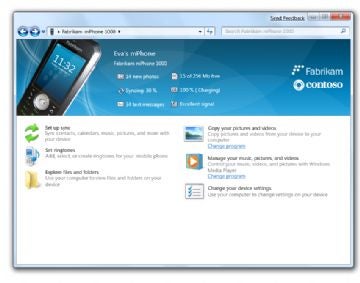
Other options might include a link to a PDF of the manual (which would save you the trouble of having to track it down on the Web) or, in the case of a cell phone, software for syncing Outlook contacts (even with a non-Windows Mobile handset).
To make these services readily accessible once you've installed a device or peripheral, Windows 7 lets you create a device icon that acts much as taskbar application icons do: The image of the peripheral appears on a taskbar button; and when you hover over it, the services in Device Stage appear as a jump list.
The Device Stage for a peripheral exists only if the vendor creates an XML document based on a Microsoft template; in order for this to happen, the vendor would have to get Microsoft to sign off on the document (Microsoft says that this prerequisite is necessary to ensure quality control). It's not clear at this point whether the overhead involved will discourage vendors from participating, but Microsoft says that the OS will download such documents whenever they're available (using the same Windows Metadata Services technology that transparently downloads cover art for albums in Windows Media Player).
Device Stage has the potential to help vendors integrate their hardware with Windows more successfully and save money on tech support (since, if you have the manual handy, you may not need to call in). The technology also gives vendors a marketing opportunity: They can prominently display their logo next to the rendering of the device on the upper half of the Device Stage window.
Another hardware-related innovation is the ability to go beyond adjusting the font size on a high-DPI (dots-per-inch) display, which you can already do in Windows Vista, and use a new Magnifier feature to enlarge a part of the display--for example, if you need to read a small block of tiny type.
Windows 7 will also pack some easy-to-use tools for adjusting external displays--specifically, to help people connect a notebook to a projector.
Ease of Networking
Networking features in Windows 7 address a number of problems that arise from the use of corporate PCs on noncorporate networks, particularly by workers who take their laptops home after work and on weekends. If you've ever spent hours trying to print on a networked home printer from a laptop tied to a corporate domain, you'll appreciate the W7-given ability to associate your notebook with a HomeGroup for easy access to printers and files on other PCs--without any tinkering with your IT department's carefully applied domain configuration settings. We haven't tested this capability yet, but Microsoft says that HomeGroup will also prevent other PCs on your home network from accessing any of the (potentially sensitive) corporate data on your laptop.
But wait: There's more. Microsoft says that Windows 7 will be smart enough to recognize when you're at home and when you're at your office. As a result, if you print a document, the OS will choose the appropriate printer to use. And a new federated search capability will let you sift through files on PCs across the network, and apply filters to your results. This means that you can do a keyword search and then refine it by specifying a specific file type.
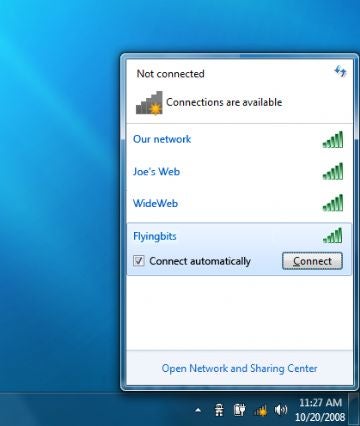
"Windows 7 promises easier Wi-Fi network and Bluetooth peripheral setup, too, though we weren't able to test either on the early beta software. Hovering over the Taskbar icon for these network adapters produces a jump list of available networks (or devices, in the case of Bluetooth); then you merely click the one you want to connect to (or pair with, in the case of a Bluetooth peripheral)."
Another improvement is wake-on-wireless-LAN, the ability to bring a Wi-Fi-connected PC out of sleep mode remotely (just as you've long been able to do with ethernet-connected systems).
Back at the office, other networking improvements only apply if your company installs Windows Server 2008 R2 and your IT department allows them. For example, you might be able to click a link in a corporate e-mail message to launch an application behind the firewall--without having to make a VPN connection first (Windows 7 will transparently handle the security arrangements).
Searching and Organizing
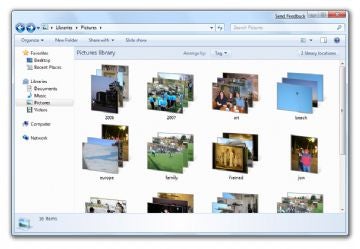
One interesting new feature in Windows 7's Explorer is called "libraries." Essentially it's a way of making like content scattered in various folders easily accessible. The OS ships with several predefined libraries--for documents, music, pictures, and video--but you can create your own based on whatever criteria you choose--file type, date created, or other metadata such as music genre.
Libraries figure actively in Windows 7's improved search: Results are organized based on libraries rather than on file locations. Windows 7 also allows you to perform so-called federated searches--searches across multiple PCs on your network. So, for example, you might search for photos across the photo libraries of all the PCs in your HomeGroup.
More Multimedia
Once upon a time, Microsoft's approach to audio and video seemed to hinge on Windows Media Player and its file formats coming to dominate digital entertainment the way Windows dominates the PC. Instead, we live in a world where multiple approaches to media flourish, and where iTunes and the iPod, not Microsoft-based products, are everywhere. Windows 7's new multimedia capabilities acknowledge this reality by emphasizing features that help the OS play well with others--including with products that hail from a certain company named after a piece of fruit.
Windows 7 aims to streamline playback, too--so much so that it offers two different lightweight ways to consume media without employing full-strength Windows Media Player. You can listen to music and watch video by using the preview pane in Windows Explorer, without launching Windows Media Player at all. Or you can load up WMP but work with a simple view that hides you media library and fits comfortably into a small floating window on your desktop leaving the rest of your display visible (and usable).
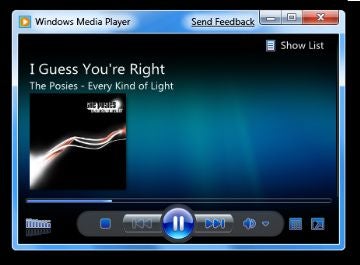
No matter how you play your files, Windows 7 handles a bunch of non-Microsoft formats that Vista and Windows XP don't, including AAC audio and H.264 video--the standards favored by Apple--as well as DiVX video and AVHDC, a format used by many high-definition camcorders. That ecumenical approach lets the media player tap into entertainment libraries that you've created using iTunes. Not surprisingly, it can't play iTunes music and movies shielded by Apple's FairPlay copy protection; but rather than showing them and then choking when you try to enjoy them, it doesn't show them at all. In our tests, the updated WMP handled unprotected AAC music without a hitch; an H.264 video podcast that we downloaded from iTunes played, but it looked much blockier than it did when we watched it in iTunes on the same Windows 7 PC.
The new OS aims to play traffic cop for an array of media types and devices that may live on your home network. It can find media stored on multiple PCs on the Internet (including ones in HomeGroups), and it can route media files from them to media-streaming devices that support the Digital Living Room Network Alliance (DLNA) standard, such as the Sonos Multi-Room Music System. If a particular piece of media is saved in a format that a specific streaming device doesn't support, Microsoft says, W7 will convert it on the fly. That sounds very slick, but the proof is in the playing: We haven't tested these networked features yet, but we'll report back when we do.
Windows Media Center, the über-application that does everything from record live TV to distribute Windows' media features to networked Xbox 360 consoles. is back in Windows 7. (Microsoft hasn't announced details regarding the versions of W7 that will be available, but Media Center will presumably be included in one or more high-end consumer editions of the OS.) Microsoft says that Media Center includes new Internet TV features that give users a single guide and playback interface for video content from all over the Web. Again, that sounds intriguing--but if the feature is available in the Windows 7 preview edition we examined, it's so well-hidden that we couldn't track it down. Media Center also works with HomeGroup networking to let you find recorded video and other media files no matter where they're hiding on your network.
On Applications
As previously reported, Microsoft won't be shipping Windows 7 with all of the bundled applications that the company has historically installed by default with the OS. Instead, it will deliver e-mail, photo gallery features, and video-editing capabilities as downloadable applications, collectively called Windows Live Essentials. Windows Live Mail, Windows Live Photo Gallery, and Windows Live Movie Maker have been available in beta form for some time.
There you can also find beta versions of Windows Live Writer (a blogging tool), Windows Family Safety (parental control tools), Microsoft Office Outlook Connector (software for using Outlook 2003/2007 as a front end to Hotmail) and Windows Live Toolbar (to make other live apps easily accessible from Internet Explorer).
Windows Live Essentials should not be (but probably will be) confused with Windows Live services, which may be associated with desktop apps but require nothing more than a browser to run. For example, Windows Live Hotmail is an e-mail client accessible only in a browser, whereas Windows Live Mail runs on the desktop.
In discussing Windows Live, Microsoft's Brian Hall noted that Microsoft has yet to offer applications that relate to social networking and user-generated content (with ratings), but he hinted that such apps may be coming. Other Microsoft officials said that new Windows Live services will be announced November 12.
Not all traditional accessories have been eliminated; some old standbys remain, with face lifts. Windows Paint's basic image-editing features are now exposed via a Scenic Ribbon à la Office 2007. The ribbon also appears in Windows 7's WordPad, and the OS's APIs will make the ribbon available to third-party developers who believe that it will benefit their applications. Though some users didn't appreciate having to learn new locations for many features in complicated Office apps, the ribbon works well for the relatively few and simple tools in Paint and WordPad.
Also in the future OS: a refresh of Calculator, and a Sticky Notes feature that supports ink (as well as text) and permits resizing of notes.
**
Bill Gates, in an interview with Newsweek, suggested that the next version of Windows would "be more user-centric."When asked to clarify what he meant, Gates said:
“That means that right now when you move from one PC to another, you've got to install apps on each one, do upgrades on each one. Moving information between them is very painful. We can use Live Services to know what you're interested in. So even if you drop by a [public] kiosk or somebody else's PC, we can bring down your home page, your files, your fonts, your favorites and those things. So that's kind of the user-centric thing that Live Services can enable. [Also,] in Vista, things got a lot better with [digital] ink and speech, but by the next release there will be a much bigger bet. Students won't need textbooks; they can just use these tablet devices. Parallel computing is pretty important for the next release. We'll make it so that a lot of the high-level graphics will be just built into the operating system. So we've got a pretty good outline."
-----------------------------------------------------------------------
Phew! Well, that was kind of exhaustive, ain't it. Yeah, actually, I have been drafting this, and also collecting from my sources since last month. It was a tough journey across the web, and time consuming to make it right!
As ever, every hard worker deserves some rest. And that's what Iam going for.
So till then,
Cya
Templar AKA Sumanth

No comments:
Post a Comment